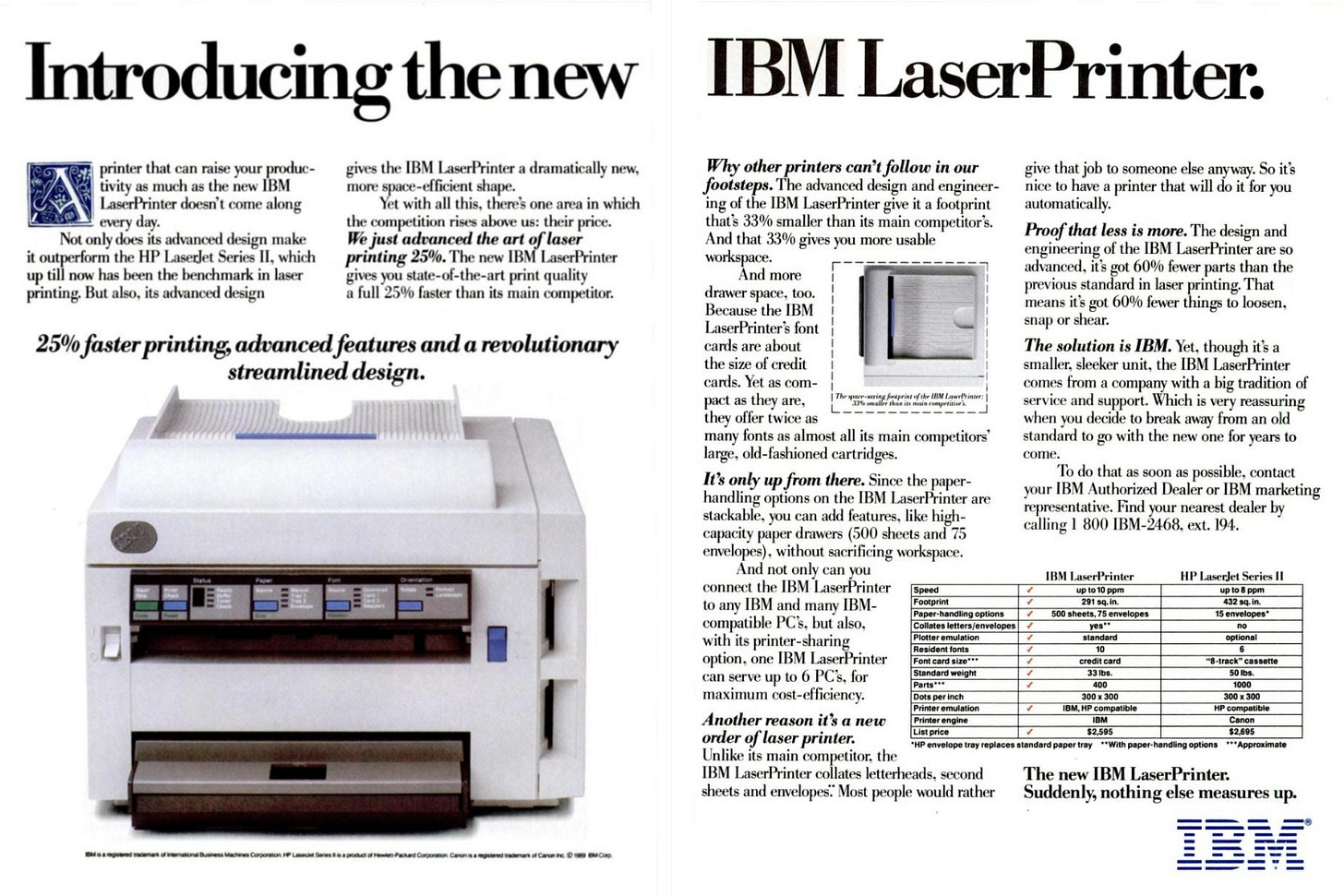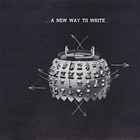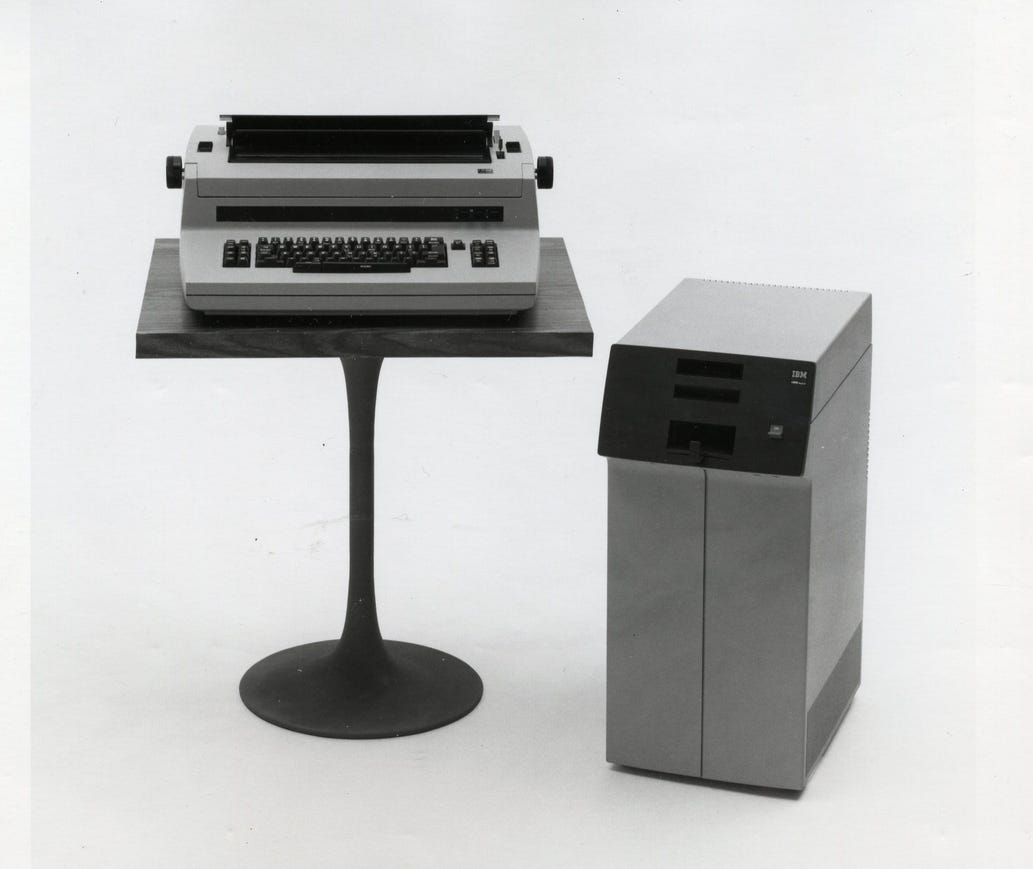Asphyxiation by Abundance
How IBM Gave Away the Laser Printer Market
This is Part Two of a three-part series on IBM’s electric typewriter division. A link to Part 1 (“Like Tears in Rain”) is below.
As I wrote in Part 1, IBM dominated the electric typewriter market for a period of nearly 60 years. It established its dominance in the late 1930s with the Model 01 and cemented it further with the revolutionary Selectric in 1961. It added plenty of additional features to the Selectric over the next twenty five years. One could even turn some of the more modern models into a printer for a personal computer, but only with plenty of time, some money, and many caveats. An article titled “The Selectric Connection” from the February 21, 1984, issue of PC Magazine affirmed the interesting possibility of extending the useful life of some of the more recent models (the 50, 60, 65, and so on), but it definitely doesn’t sound like a ringing endorsement:
In fact, despite outlining how one might transform a modern Selectric into a PC printer, Holzman at the end lists the limitations and impossibilities. Then he just just recommends against the idea altogether: “If you are looking for a letter-quality printer, you haven’t found it in your Selectric typewriter.”
Just because it can be done, doesn’t mean it should be!
The Selectric is Dead, Long Live the Selectric
Despite adding scads of improvements to its flagship electric typewriter, IBM would retire the Selectric line in 1986. Businesses and consumers just preferred the greater functionality that personal computers—especially when combined with cheaper laser printers and high quality desktop publishing software—could provide.
FURTHER STUDY
Andvari Associates published a white paper in 2020 providing a retrospective view on the desktop publishing software business that grew up in the 1980s. The combination of personal computers, cheap laser printers, and software from companies like Aldus Corporation, was instrumental in enabling the high quality and cost-effective publishing and printing at the consumer and small business level.
“Slug, Bleed, Trim & Type: Enduring Lessons From 35 Years of Desktop Publishing Software”, Andvari Associates LLC, December 2020.In addition to the Selectric, IBM also designed and made other typewriter models as well as computer printers and keyboards. The pace of innovation was accelerating during the 1980s and IBM’s culture and style of management was a handicap that prevented it from effectively competing in a faster-moving world.
Wang Laboratories came out with dedicated word processors in 1970s that enabled faster and easier editing and could perform mail merges that allowed for uniquely addressed letters. New printers came out using “daisy wheels” that enabled faster printing than a Selectric. Manufacturers had also developed low-cost inkjet printers for personal computers, but the print quality was less than professional looking relative to an expensive laser printer.
Laser Printers for the Masses

Prior to 1984, laser printers were so expensive that they were only bought by large enterprises with high standards for print quality and print volume. The laser printers producing items like bank statements and invoices cost hundreds of thousands of dollars. Then came cheaper laser printers from companies like Quality Micro Systems and Symbolics, Inc. that retailed for $25,000 in 1984. These prices were still far out of reach for the average consumer or small business, but prices would fall drastically again thanks to an innovative company based in Asia.
Japanese camera and optics company, Canon, would be the first to show a consumer laser printer was possible. First, in 1979, Canon created the world’s first desktop laser printer, the LBP-10. They then developed an improved print engine called the Canon LBP-CX. Interestingly, Canon offered to sell their core laser technology to anyone. Their rationale was that their technology would reach a far greater audience if they partnered with established companies like HP and Apple.
Canon’s partnership model, especially with HP, succeeded wildly. HP’s first LaserJet printer, introduced in May 1984, quickly became popular and helped establish HP as a leader in the laser printer market for consumers.
Canon’s innovations significantly advanced laser printers into the consumer market. According to the HP Computer Museum:
“One of the most significant technology breakthroughs offered by the original LaserJet (Canon CX engine) was the use of an all-in-one toner cartridge. Instead of replacing toner and quick-wearing parts (drum, cleaning system, etc) separately, users would just purchase a new all-in-one cartridge.”
From a New York Times article in November 1984:
Slow, clunky and noisy printers have long been the weak link in personal computing systems. Dot-matrix printers are quick, but the print quality usually ranges from terrible to not-so-hot. Daisy-wheel printers produce letter- quality pages, but at an agonizingly slow pace. High-quality graphics are beyond the ability of either type.
Laser printers may be the answer. Using a highly focused beam of light to write on a photocopier-type drum, they produce clean, letter-quality copy so fast that the usual measure of printer speed, characters per second (c.p.s.), is left in the dust. Laser printer speed is usually measured in pages per minute, and some of the big monsters employed by junk mail producers can crank out two or more pages a second. Even at that rate the user can vary the size and style of the type faces and include quality graphics and half-tone photographs on the same page. Theoretically, they can print everything on this newspaper page, only better.
The drawback has been price, usually measured in five or six digits. Now, however, laser printers are becoming available for less than $3,000, or only slightly more than a 60 c.p.s. daisy-wheel printer cost a year or two ago.
HP’s LaserJet came out with a $3,495 list price in 1984—compare this to the next least expensive option which was four times the price of the LaserJet. Apple started shipping its LaserWriter for $6,995 in March 1985. Perhaps even more amazing in regards to the LaserJet was it took HP only one year to develop and it sold 225,000 units in its first year. HP would would proceed to take the lion’s share of the laser printer market, reaching between 60% and 70% share by 1993.
Whither IBM’s Consumer Laser Printer?
As mentioned before, IBM had developed its own high-end laser printers for owners of its expensive mainframe computers. IBM’s top-of-the-line 3800 laser printer sold for $315,000 in 1984. They had the tech know-how, but decided not to develop a lower-end consumer model. The most important rationale was cost. IBM knew that the mirror component (used to direct the laser of the printer) alone cost several thousand dollars, which in turn would make their printer far too expensive for consumers. Does this sound at all similar to Kodak having developed the first digital camera but choosing not to bring it to market due to high costs and worries of cannibalization?
Also, although Canon’s laser printer engine became available for purchase in 1983, IBM was unsurprisingly too proud to use any technology that it had not developed in-house. It would take IBM five years to further develop its own technology to reach a consumer price point. They finally released their own cheap laser printer—a product lifelessly named “LaserPrinter”—in 1989. For the lower-end consumer market, IBM’s laser printer was too little and far too late.

Time for a Deal
As I noted in Part 1 of this series, IBM was facing many challenges in the mid-1980s. Faster moving competitors were taking share in old and new product lines. Under Chairman John Akers, IBM restructured multiple times and tens of thousands of employees chose to accept IBM’s offer of early retirement. From 1986 to the end of 1992, Akers shrunk headcount from 407,000 to 327,000. Cash was going out the door just at the time revenues and profits were under strain. Akers and the board would eventually cut IBM’s annual dividend of $1.21 in 1992 to $0.40 per share in 1993, and then again to $0.25 per share in 1994.
Thus, in a quest to raise money and increase profitability, Akers formally grouped IBM’s printers, word processors, typewriters, and peripherals, into a new corporate entity they would name Lexmark International. This was an easy set of products to jettison. It had both lower margins and a lower growth profile. IBM announced in August 1990 they would sell a majority stake in Lexmark to Clayton Dubilier in a leveraged buyout valued at $1.5 billion.
Key Takeaways
Here are three key takeaways from this period of time for IBM’s printer and typewriter division:
Too much knowledge can be as much a curse as hubris
Abundance can asphyxiate
Incentives matter
Curse of Knowledge
IBM had laser printer technology, but chose not to refine it to tap into the large consumer and small business market. They knew their technology too well. Just the reflecting mirror itself made a low-cost model impossible, so they simply didn’t pursue it. In doing so, they gave Canon time to develop an extremely low-cost laser printer engine. Canon then offered to sell the technology to anyone. IBM was too proud to buy technology that wasn’t their own, HP was not, and HP in less than ten years had 70% of the laser printer market.
Asphyxiation by Abundance
In addition to an abundance of pride and knowledge, IBM, even in the trying mid- to late-1980s, also still had an abundance of financial resources. But this just meant there was little incentive for anyone in IBM to keep costs to a minimum like at a new start-up. IBM for decades coasted on its success, thinking customers would keep buying anything with an IBM logo on it. Further, throughout its long existence, IBM had a policy of ensuring lifetime employment for its employees.
For the same reason that having constraints placed on you can often lead to greater creativity and productivity, an over-abundance of resources—time, money, HR and legal professionals, overly-robust operating procedures, and guaranteed employment regardless of performance—will retard speed, creativity, and productivity.
Misaligned Salespeople
IBM divided its sales force mostly by geography, not by product line. Each sales person could sell almost any IBM product. Thus it is no surprise they focused on selling the highest ticket items with the fattest margins. The lower value items with lower margins—the typewriters and printers for regular consumers—were received relatively less attention. With a dedicated salesforce and a product-specific go-to-market strategy, IBM maybe could have bolstered the growth and market share of its printers and typewriters during the 80s.
Postscript
Please stay tuned for the last part in this series on IBM’s electric typewriter division where I’ll be discussing the LBO of Lexmark by Clayton Dubilier.
Part III of the series is now available below.
Sources
“Printing with a Laser Beam”, PC Magazine, May 15, 1984.
“Combining Laser Speed and Graphics With Letter-Quality Output”, Personal Computing, August 1984.
“The Allure of Laser Printers”, New York Times, Nov. 20, 1984.
“Fast Printers for the Home Market”, New York Times, April 7, 1985.
“Laser Puts Printing Plant in Home”, New York Times, Sep. 3, 1985.
Carroll, Paul. Big Blues: The Unmaking of IBM. New York: Crown Publishers, Inc., 1993.
Please Subscribe
If you enjoyed this content, please share and subscribe.
Disclaimers
The content of this publication is for entertainment and educational purposes only and should not be considered a recommendation to buy or sell any particular security. The opinions expressed herein are those of Douglas Ott in his personal capacity and are subject to change without notice. Consider the investment objectives, risks, and expenses before investing.
Investment strategies managed by Andvari Associates LLC, Doug’s employer, may have a position in the securities or assets discussed in any of its writings. Doug himself may have a position in the securities or assets discussed in any of his writings. Securities mentioned may not be representative of Andvari's or Doug’s current or future investments. Andvari or Doug may re-evaluate their holdings in any mentioned securities and may buy, sell or cover certain positions without notice.
Data sources for all charts come from SEC filings, Koyfin, and other publicly available information.








The Innovator's Dilemma -Clayton Christensen's framework nicely explain why Incumbent struggle to bring disruptive technologies into the market. He also explain when a company should do M&A, process changes etc. incubate disruptive tech highly recommend incase u haven't gone through. In fact he used Lexmark as a case study in the book.